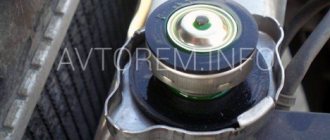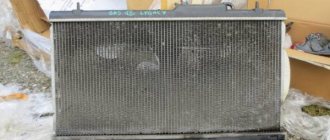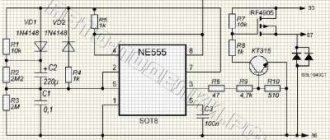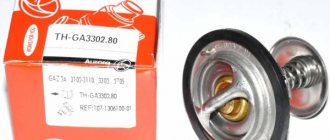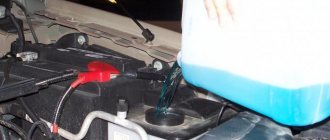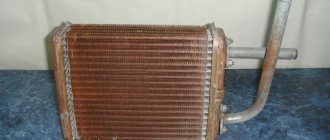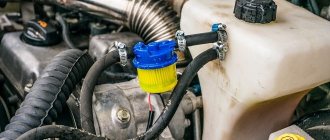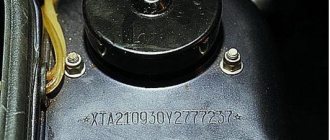How often to wash
Before we move on to a direct description of certain products, I would like to remind you how important it is to regularly flush the car’s cooling system. The fact is that, depending on the coolant used, rust, oil deposits, antifreeze decomposition products, and scale accumulate on the walls of the tubes that make up the radiator. All this leads to difficulty in coolant circulation and reduced heat transfer. And this always has a bad effect on the performance of the engine and increases its wear.
individual parts with the risk of their premature failure.
It is worth noting that flushing the system can be both internal and external (external cleaning involves flushing the radiator from the outside to remove particles of dirt, dust, and insects on its surface). It is recommended to flush the internal cooling system at least once a year. It is best to do this in the spring, when there is no longer frost, and a hot summer lies ahead.
On some cars, there is a light on the dashboard with a picture of a radiator, the glow of which may indicate not only a decrease in the antifreeze level, but also that it is time to change it. This may also serve as a signal that it is time to clean the cooling system. There are also a number of indirect signs of the need for such cleaning:
- frequent engine overheating;
Radiator icon indicating problems with the cooling system - problems with the pump;
- slower response to rheostat signals (inertia);
- high temperature readings from the corresponding sensor;
- problems in the operation of the “stove”;
- The fan always runs at high speed.
If the engine gets very hot, then it’s time to select a product to flush the cooling system, and choose the time and opportunity for this.
Engine flushing requirements
When is it necessary to flush the engine? As a rule, experts recommend doing this work in the following cases:
Thus, the question of the importance, benefit or danger of flushing the power unit after using old oil remains open. Both options (with and without flushing) have their own characteristics, pros and cons.
At the same time, you must understand what risks exist for the engine in a given case. Good luck on the roads and of course no breakdowns.
General view of the VAZ 2107 car engine
To increase the service life of the engine of a VAZ 2107 car, it is necessary to monitor the serviceability of its parts. Good lubrication is one of the criteria for keeping the unit in working order.
Factors influencing oil change intervals:
Folk remedies for flushing the cooling system
As we indicated above, there are two types of cleaning products - traditional and special. Let's start with the first ones, as they are cheaper and more proven.
Lemon acid
Using citric acid to clean the cooling system
The most common citric acid, diluted in water, can clean radiator tubes from rust and dirt. It is especially effective if ordinary water is used as a coolant, since acidic compounds are effective against rust, and alkaline ones are effective against scale. However, remember that a citric acid solution is not able to remove significant stains.
The composition of the solution is as follows - dissolve 20-40 grams of the substance in 1 liter of water, and if the contamination is strong, then the amount of acid per liter can be increased to 80-100 grams (a larger volume is created in a similar proportion). The ideal option is when adding acid to distilled water, the pH level is around 3.
The cleaning procedure itself is simple. It is necessary to drain all the old fluid and fill in a new solution. Next, you need to warm up the engine to operating temperature and leave it for several hours (or better yet, overnight).
Next, drain the solution from the system and look at its condition. If it is very dirty, then the procedure must be repeated 1-2 more times until the liquid is clean enough. After this, be sure to flush the system with water.
Acetic acid
Using acetic acid to clean the cooling system
The action of this solution is similar to that described above. An acetic acid solution is excellent for flushing the cooling system from rust. The proportions of the solution are as follows - half a liter of vinegar per bucket of water (10 liters).
The cleaning procedure is similar - drain the old fluid, fill in new fluid and warm up the car to operating temperatures. Next, you need to leave the car with the engine running for 30-40 minutes so that chemical cleaning occurs in the radiator. Next, you need to drain the cleaning liquid and look at its condition.
Repeat the procedure until the liquid becomes clear. Next, you need to rinse the system with boiled or distilled water, and then fill in the coolant that you plan to use on an ongoing basis.
Fanta
Using Fanta to clean the cooling system
Similar to the previous point. However, there is an important difference. The fact is that, unlike Coca-Cola, which uses orthophosphoric acid, Fanta uses citric acid, which has a lesser cleansing effect. Therefore, some car owners use it instead of antifreeze to clean the cooling system.
As for the time during which you need to drive like this, it all depends on the degree of contamination of the system. In particular, if it is not very dirty, and cleaning is done more for prevention, then it is enough to let the engine run for 30-40 minutes at idle speed. If you want to thoroughly wash out the old dirt, then you can ride like this for 1-2 days, then pour distillate into the system, ride it some more, drain it and look at its condition.
If the distillate is dirty, repeat the procedure until the system is clean. At the end, do not forget to rinse it thoroughly with water and fill it with new antifreeze.
Please note that if there are small holes or cracks in the stove pipeline, but they are “closed in” by dirt, then when flushing these holes may open and a leak will form. Therefore, after flushing, inspect the system pipelines.
Lactic acid or whey
An excellent option for flushing the cooling system of a car engine is this.
Using whey
lactic acid. However, a significant problem lies in the fact that lactic acid is very difficult to obtain today. But if you manage to get this substance, then you can pour it into the radiator in its pure form and drive it for a while (or let the car sit with the engine running).
A more affordable alternative to lactic acid is whey. It has similar properties for cleaning the radiator and other elements of the cooling system. The algorithm for using the serum is as follows:
- Prepare about 10 liters of whey in advance (preferably homemade, not from the store);
- strain the entire purchased volume 2-3 times through cheesecloth in order to filter out large pieces of fat;
- first drain the existing coolant from the radiator and pour in the serum in its place;
- drive 50-60 kilometers with it;
- It is necessary to drain the whey while it is hot, so that the dirt does not have time to stick to the walls of the tubes again (be careful when doing this!);
- let the engine cool down;
- pour pre-boiled water into the radiator;
- start the engine, let it warm up (about 15-20 minutes);
- drain the water;
- let the engine cool down;
- fill in the antifreeze that you plan to use on an ongoing basis;
- Bleed air from the system and add more coolant if necessary.
Please note that the serum has its cleansing properties for 1-2 hours. Therefore, the mentioned 50-60 km must be covered during this time. It makes no sense to drive longer, since the serum mixes with the dirt in the system.
Caustic soda
This substance is popularly called differently - sodium hydroxide, “caustic alkali”, “caustic soda”, “caustic” and so on.
The substance can only be used to clean copper radiators (including stove radiators). You cannot clean aluminum surfaces with baking soda. In accordance with the official instructions of the manufacturer of copper radiators, it is necessary to act according to the following algorithm:
- remove the radiator from the car;
- rinse its insides with plain water and blow with compressed air (not exceeding a pressure of 1 kgf/cm2) until clean water flows out of the radiator;
- prepare about 1 liter of 10% caustic soda solution;
- heat the composition to at least +90°C;
- pour the prepared mixture into the radiator;
- let it brew for 30 minutes;
- drain the solution;
- for 40 minutes, rinse the insides of the radiator with hot water and blow with hot air alternately (the pressure should not exceed 1 kgf/cm2) in the direction opposite to the direction of movement of the pump.
Remember that caustic soda causes burns and corrodes living tissue. Therefore, it is necessary to work outdoors wearing gloves and a respirator.
As a result of the chemical reaction, white foam may appear from the radiator pipes. If this happens, do not be alarmed, this is normal. The tightness of the cooling system after cleaning must be carried out on a cold engine, since hot water quickly evaporates, and finding the suspected leak location will be problematic.
How to flush the lubrication system on all VAZ cars?
1) Flushing is actually quite simple, you can find more details on how to flush the lubrication system with one or another flushing fluid on the jar itself in which the flushing fluid is located, usually all jars have instructions for their use and they are all used in different ways, some kind of flushing fluids need to be used by starting the engine of the car and letting it run for 15 minutes so that the remaining oil leaves the system, some kind of flushing fluids need to be mixed with the engine oil itself and then drive 100-200 km and thereby The engine will also be cleaned, so as you already understand, you need to look at the instructions on the jar of liquid as everything is described in detail on it.
2) But so that you don’t forget, always remember a few rules, namely, before purchasing a fluid, make sure that it is suitable for your oil, that is, the flushing fluid is for mineral oils, as well as for synthetic oils, etc., therefore, when choosing a flush, take this into account; in addition, also pay attention to which car engine the flush is used for and you do not need to take a flush for diesel cars if in fact you have a gasoline one.
Note! In addition, if you want to make the flushing better, then you can buy a new oil filter at the auto store and install it only for the time of flushing; it doesn’t make sense to buy something too expensive since you will only need to install it and then throw it away, so take a relatively cheap one a filter that would simply act as a plug (so that oil does not leak out of the engine), and it is recommended to install a new one during flushing only because your old filter is dirty and mixing the flushing fluid with dirt will only weaken the flushing effect and thus it will not as good as it should be!
Additional video clip: For more information on how to flush the engine lubrication system, see the video located just below, everything is described in detail.
What is not recommended for flushing the cooling system?
Among the so-called folk remedies, there are a number of those that are not recommended for use, despite the fact that some car owners still use them, and in some cases they even help. Let's give a few examples.
Coca-Cola
Using Coca-Cola as a Cleaner
Some motorists use Coca-Cola to flush the cooling system of oil, emulsion, scale and rust. The fact is that it contains orthophosphoric acid, with which you can easily get rid of the mentioned contaminants. However, in addition to acid, this liquid contains large amounts of sugar and carbon dioxide, which can lead to certain problems.
If you decide to use Cola as a cleaning liquid, it is better to first release carbon dioxide from it so that during the expansion process it does not harm individual engine components. As for sugar, after using the liquid, you must thoroughly rinse the cooling system with plain water.
Also remember that phosphoric acid can harm plastic, rubber and aluminum parts of the cooling system. Therefore, “Cola” can be kept in the system for no longer than 10 minutes!
Fairy
Some car enthusiasts use the popular household grease cleaner Fairy or its analogues to flush the cooling system of oil. However, its use is associated with a number of problems. Firstly, its composition is designed to combat dietary fat, and it simply cannot cope with motor oil. And even if you try to pour it into the radiator, you will have to fill and “boil” the engine several dozen times.
Therefore, we DO NOT recommend that you use household grease removers like Fairy and similar products.
Calgon and its analogues
Calgon, Tiret and similar products are not recommended for cleaning radiators, since their intended purpose is to remove limescale deposits on water pipes.
"White"
The peculiarity of “Belizna” is that it contains sodium hypochlorite, which corrodes aluminum. And the higher the temperature of the liquid and the working surface, the faster corrosion occurs (according to the exponential law). Therefore, under no circumstances should you pour various stain removers into the system, especially those containing bleach and compounds based on it (including “Mr. Muscle”).
"Mole"
Known in narrow circles, “Mole” is made on the basis of caustic soda. Accordingly, they cannot be used to treat aluminum radiators and other surfaces. It is only suitable for cleaning copper radiators (in particular, stove radiators) and only by removing it and running such a cleaner through the system will you kill all the rubber seals and seals.
Other mixtures
Some car enthusiasts use a mixture of citric acid (25%), soda (50%) and vinegar (25%) for cleaning. However, we do not recommend that you do the same, since it is very rough and corrodes rubber and plastic parts. These cleaning agents are only permissible if you need to flush the stove radiator and you do not plan to circulate liquid throughout the cooling system.
How to wash an engine
Now let's move on to the most important thing - the procedure for washing the power unit . There is really nothing complicated here, if you carry out the preparation stage correctly and equip yourself with everything necessary and effective for carrying out the procedures.
- Select the location where the washing will take place. If you have just arrived, wait a while for the engine to cool down. If you apply detergents to heated surfaces, they will begin to dry quickly, which will result in higher consumption.
- Apply the product of your choice, preferably one specialized for engines, and leave for 15 minutes to react with the contaminants. The manufacturer provides clear instructions for use on each product, so follow these recommendations.
- If the engine is covered in a thick crust of dirt in some places, you should not rely on detergents. It is much easier to remove a layer of dirt with a scraper, a regular screwdriver or a small spatula, and then bring the surface to perfection using detergents. Have a thin brush on hand that you can use to reach hard-to-reach places in the engine compartment.
- Detergents that have already reacted are washed off with plain water. Preferably under pressure. To do this, you can connect the hose to the tap, or use manual car washes. The latter generally significantly simplifies the process of washing both the body and the engine.
- If you do not have a machine for supplying compressed air, which is used to dry the engine at car washes, simply place the VAZ 2114 in the open air with the hood open. When it’s raining outside, this drying option will not work, as you understand.
- Since you used plenty of water to wash the engine, it is imperative to carry out a procedure that will prevent corrosion. For this, a solution is used, which contains equal parts of water and soda. Treat metal surfaces and, of course, the battery with this mixture, then wipe with a damp cloth and let dry in the sun.
Washing the engine on a VAZ 2114 is not the easiest procedure due to some subtleties and potential problems that can result from contact of water with the engine compartment. That’s why many car owners trust professional car washes to clean their engines from dirt. Just make sure they take responsibility if the spark plugs are flooded or the wiring is loose. Since such a point is not present everywhere.
Source
Special liquids for flushing the radiator
The means listed above, of course, can be used to flush the radiator and cooling system of a car, but they have already become obsolete both morally and technologically. Currently, auto chemical manufacturers offer consumers a wide range of different cleaning products that cost quite reasonable money, that is, affordable to the average car owner.
Types of liquids
There are several types of cleaning fluids for radiators, which are divided by chemical composition. In particular:
- Neutral. Such liquids do not contain aggressive substances (in particular, alkalis and acids). Therefore, they are not able to wash away significant contamination. As a rule, neutral compounds are used as prophylaxis.
- Acidic. As the name implies, their composition is based on various acids. Such liquids are excellent for purifying inorganic compounds.
- Alkaline. Here the basis is alkali. Excellent for removing organic contaminants.
- Two-component. They are produced on the basis of both alkalis and acids. Thus, they can be used as a universal cleaner to flush the cooling system of scale, rust, antifreeze breakdown products and other compounds.
Do not use two different products at the same time. Limit yourself to one! Also, do not use very concentrated alkaline or acidic compounds, as they can damage the rubber and plastic elements of the system.
Popular liquids
We present for you an overview of the most popular liquids in our country for flushing a car’s cooling system, as well as some reviews from car enthusiasts who have used this or that liquid. We hope that the information below will be useful to you, and you will know the best way to flush your cooling system.
Flushing the engine when changing the oil. How to properly flush the engine.
Someone needs it, for someone this article will explain it, but someone gives a damn about Oleyn and him
How often, when you go to a car service center to change the oil, do you hear from the servicemen a proposal to flush the engine before adding fresh and new oil. There seem to be plenty of arguments prompting this “event”: firstly, it is unknown who and when was the last time the oil in the car was changed “correctly” (that is, on time and using high-quality oil). Secondly, working on the principle “every sandpiper praises his own swamp,” a service predisposed to using oil from one manufacturer will definitely advise flushing the system if oil from another manufacturer has been used before. Thirdly, the most “advanced” oil change technician will certainly look under the oil filler cap, or, on the contrary, at the oil level dipstick, and give his verdict - the oil is dirty, it’s better to rinse it. It seems that everything is simple - it’s necessary, it’s necessary, engine hygiene is a useful thing, who would doubt it. But let's not rush, and let's still see what happens when flushing the engine.
TOP 3 best liquids for flushing the cooling system
LAVR Radiator Flush Classic. LAVR is a Russian brand of auto chemical goods. LAVR product.
Radiator Flush Classic is an excellent solution for flushing the cooling system of any car. Product catalog number is LN1103. The approximate cost of a 0.43 liter package is $3...5, and a 0.98 liter package is $5...10.
A 430 ml bottle will be enough for you to use in a cooling system with a total volume of 8...10 liters. The composition is poured into the system and topped up with warm water to the MIN mark. After this, the engine should run for about 30 minutes at idle speed.
Next, the product is removed from the system and washed with distilled water for 10...15 minutes with the engine running at idle. After this, you can fill in new antifreeze.
The useful properties of the product include increasing the service life of antifreeze by 30...40%, effective removal of scale, antifreeze decomposition products, rust, and dirt. Contains a corrosion inhibitor, increases the life of the pump and thermostat.
| Positive feedback | Negative reviews |
| I simply used the Laurel wash because literally shortly before I had just used a ring decarbonizer under the same name, I saw the result, so I decided not to tempt fate and use a product from the same company... | No negative reviews found. |
| At one time I also used Laurel on a VAZ-21099. The impressions are only positive. But I also did washings every two years. So I never had dirt in the cooling system. |
7-Minute Hi-Gear Radiator Flush
Hi-Gear Radiator Flush - 7 minutes. Manufactured in the USA by Hi-Gear. Sold in the CIS countries, as well as Europe and America.
Hi-Gear cooling system flushing is a very popular remedy among motorists all over the world. Article: HG9014. The price of one 325 ml can is about $4...6.
A 325 ml can will be enough for you to flush a cooling system with a volume of up to 17 liters. The product can be used to clean cooling systems of cars and trucks. A distinctive feature is the short operating time, namely 7 minutes.
The useful properties of the product include the fact that it increases the efficiency of the radiator by 50...70%, eliminates overheating of the cylinder walls, restores coolant circulation, reduces the likelihood of engine overheating, and protects the pump seal. The product does not contain acids, does not require neutralization, and is not aggressive to plastic and rubber parts.
| Positive feedback | Negative reviews |
| I have been using Hi-Gear (USA) flushing products from this company since I purchased my first car, I have never had any complaints, especially with “injector cleaners” | I liked the Hadov washing system better + it’s cheaper. |
| After the cheap wash it didn't get any better, but high gear helped |
LIQUI MOLY Kuhler-Reiniger. This is a popular remedy from the famous German.
LIQUI MOLY Kuhler-Reiniger
auto chemical manufacturing company. It can be used in any cooling and heating systems. Does not contain aggressive alkalis and acids.
The approximate price of a 300 ml can is $6...8. Article - 1994.
Perfect for car owners who want to flush the engine cooling system of oil, emulsion and rust. A 300 ml jar is enough to create 10 liters of cleaning liquid. The product is added to the coolant and the engine is left running for 10...30 minutes. After this, the system is cleaned and new antifreeze is added.
The cleaner dissolves fat, oil and lime deposits, removes dirt and sediment. The substance is neutral to plastics, rubber, compatible with any coolants. Does not contain aggressive acids and alkalis.
| Positive feedback | Negative reviews |
| To be honest, I was surprised by the result, the oil in the pipes was washed away, I ran my finger inside the pipe, not even a hint of oil remained. | I washed it with licumol and it didn’t do anything, but the foam is still standing in the tank. The info said that it even removes rust, and yes, it was exactly the opposite. |
| After replacing the heater radiator, I filled it with dis/water, it washed out well, why I say it’s good, because my old antifreeze was basically clean, it was just time to change it, and after washing a little scale came out, then I filled it with new antifreeze, so now it’s like a tear, only bluish. | Tried Liqui Molly on an old car - in my opinion it's garbage |
As a rule, on the packaging of each cooling system cleaner you will find instructions for its use. Be sure to read it before using it directly. This is not a complete list of products for cleaning the cooling system of cars, which are sold in stores in our country. However, we focused only on the more popular ones, since they have proven themselves better than others.
Checking the oil level
Instructions for checking the oil level:
- Let the car sit with the engine off for about five minutes.
- Pull the dipstick out of the guide tube.
- The probe is wiped and installed back into the device until it stops.
- The oil film level is removed and re-checked on the indicator, which should be between the minimum and maximum.
Advice: It is necessary to ensure that oil is not poured into the engine crankcase above the maximum mark, which can lead to fluid leakage through the seals, crankcase ventilation system and oil gaskets. If oil gets into the combustion chamber of a VAZ 2107 car that has a catalytic converter, the latter may fail.
- If the reading is below the minimum, add oil. When changing the oil in a VAZ 2107 engine, you cannot use a pointer that has a different marking.
For anyone who does car repair work with their own hands and wants to see in detail how the oil is changed in a VAZ 2107 engine, the video will show all the nuances. After a timely replacement of the oil in the VAZ 21074 engine with a new one, the service life of the entire vehicle increases significantly.
Welcome! Engine lubrication system - this includes the crankshaft (Plays a very important role), as well as the camshaft, engine crankcase and many other parts, the lubrication system is one of the most important engine systems and when it is empty (Means if the oil pour everything out of the engine), the engine will not work for a long time when it’s running, maybe it will still work for 3-4 minutes at most, but then it will simply become unusable and you will have to throw it out, in addition, the lubrication system (Many people are surprised when this they hear) cools the car engine and the engine oil itself prevents it from heating up too much.
Note! In order to flush the system, you will need: A jar with flushing liquid, as well as a set of keys with which you will unscrew the drain plug, a rag so that you can wipe your hands from dirt, and a container into which the waste liquid will be drained!
Summary:
When should you flush the lubrication system? We recommend that you flush after pouring low-quality oil into the engine, which literally after 100-200 kilometers will lose its color and turn black (In this case, you need to be 100% sure that the lubrication system is not contaminated, otherwise it may happen that you drove on old oil too long and after pouring a new one it quickly turns black and people wonder why so quickly, this all happens because the old oil pollutes the system and remains on the walls, thereby mixing with the new oil, it also pollutes it), and also flushing should be done if you noticed that the pressure in your lubrication system has dropped (In this case, the emergency pressure light will light up when the engine is running, which is indicated by an arrow in the photo below for clarity).
conclusions
As you can see, the choice of OS cleaning products is quite wide. We recommend that you use professional products, and not various folk methods that are used to flush the engine cooling system at home, when it is not possible to buy special products. This way you will protect the cooling and other systems of your car from possible breakdowns and extend their service life. Since various acids corrode not only the sediment, but some components and parts of the OS.
Also remember that if you want to switch from one brand of antifreeze to another, you must always flush the cooling system with clean distilled water. This is the simplest and cheapest method of preventive cleaning of the OS. If you find an error, please select a piece of text and press Ctrl+Enter.
Didn't find the information you are looking for? on our forum.
The engine cooling system is of great importance, since without it the engine will overheat and will be unsuitable for further operation. Therefore, the serviceability of this system is very important in a car, and keeping it in good condition is simply necessary.
Engine cooling radiator.
When is engine flushing not necessary?
There is no need to flush the engine in the following cases:
New car . You bought a car from a dealership and want to start using it. If the car is under warranty and you have a document confirming this, there is no need for you to take the initiative and wash anything anywhere. This, as they say, is a “headache” for the service station that will perform after-sales service. In your case, the most important thing is to clearly monitor the quality of work performed, as well as the schedule, so as not to accidentally miss scheduled maintenance.
Regular oil changes . If you do a routine engine oil change, you don't need to flush the engine every time, just change the oil and oil filter regularly. If you really want to, you can wash it every 10th replacement, for example, or more often, it all depends on a large number of factors.
DIAGRAM AND DEVICE OF THE COOLING SYSTEM
The cooling system of the VAZ 2114 is liquid, with forced circulation. Antifreeze or antifreeze is poured into the system as a coolant. In the most extreme case, you can fill it with water, but you can’t drive it for a long time - in winter you can defrost the engine, and during the rest of the season, when the engine is used for a long time on water, the cooling jacket in the block and cylinder head is corroded, and rust accumulates in the radiator.
The VAZ 2114 engine cooling system (SOD) consists of the following elements:
- Radiator. It is the main cooling part in the system and performs the function of transferring heat to the liquid into the surrounding airspace;
- Water pump (pump). The pump creates forced movement of antifreeze in the system, thereby cooling the entire SOD, including the internal combustion engine (ICE). The pump rotates from the timing belt;
- Branch pipes (hoses). Antifreeze circulates through them;
- Thermostat. It regulates the passage of coolant through all pipes or only in a small circle and maintains the required operating temperature of the internal combustion engine;
- Electric fan. The fan is located on the plane of the radiator and, due to the air flow created, cools its surface when turned on. The electric motor turns on only when the temperature set by the sensor is reached (103°C);
- Expansion tank. Liquid is poured into the tank, and when the fan is activated, antifreeze flows into it through the return hose, thereby releasing excess pressure into the SOD;
- Expansion tank plugs. There are valves in the plug that relieve excess air pressure created in the system when antifreeze circulates.
The VAZ 2114 cooling diagram is shown in the figure below:
Cooling diagram of the VAZ-2114 The diagram of the engine cooling system on the VAZ model 2114 is simple and practically no different from the diagram of any other fuel-injected internal combustion engine of a passenger car. After starting the engine, the water pump is driven by the rotating crankshaft through the timing belt. The pump creates coolant circulation in the system, and the antifreeze passes through a small circle (pump, upper pipe, cylinder block). When the internal combustion engine is heated to operating temperature, the thermostat valve opens and the coolant flows through the lower pipe into the internal combustion engine in a large circle.
Flushing the engine oil system: when needed
So, antifreeze or antifreeze can get into the lubrication system for various reasons, but the most common culprit is damage. Rarely formed. In any case, the result of mixing oil and coolant is an emulsion.
This phenomenon is very dangerous for the motor, since the lubricant loses its properties, wear and tear of other elements and components in the engine increases significantly. Moreover, water and ethylene glycol, mixed in certain proportions and, in fact, representing coolant, after entering the oil, cause coagulation of various contaminants.
Simply put, dirt in the lubrication system literally sticks together. Additives in oil and antifreeze react after mixing and quickly decompose, the oil immediately oxidizes, etc. Large “lumps” consisting of deposits can even clog the oil receiver mesh filter, as a result it begins.
It is important to take into account that, for example, after replacing the cylinder head gasket, it will not be possible to completely drain the waste from the engine. This means that if you fill in a new portion of fresh lubricant, the lubricant will also mix with the remaining emulsion, and unwanted deposits will still form in the oil channels and on the internal surfaces of the engine.
If the engine is not additionally flushed, this situation will repeat for at least 2-3 more replacements. We also note that similar recommendations also apply when, for some reason, the oil change interval was violated (for example, the lubricant was replaced not after 10 thousand km, but after 15 thousand). Also, flushing is recommended if necessary, adding oil from a third-party manufacturer, when necessary, etc.
At the same time, flushing the engine may be necessary if the owner purchased a used car, and the service history of a particular car is unknown or questioned. It often happens that after changing the oil on such a car (literally after 50-100 km).
Finally, it is also worth highlighting the possible filling of low-grade oil into the engine. Among motor oils, unfortunately, . Naturally, after discovering this fact, you need to remove the surrogate from the internal combustion engine, then the engine must be flushed.
A counterfeit product is usually indicated by strong and rapid blackening of the lubricant, an unpleasant pungent odor, the appearance of a black coating under the valve covers, cloudiness of the oil, a significant change in its viscosity for no obvious reason, an increase in lubricant consumption, etc.
COOLING SYSTEM PROBLEMS
As a rule, due to malfunctions in the cooling system, the engine overheats, and this leads to engine failure. Any of the elements may be faulty. Radiator:
- It may leak. Possible leakage through aluminum tubes and plastic tanks. Often the plastic outlet for the return hose of the expansion tank breaks off.
- It may clog, and for this reason the engine will heat up.
Pipes. Because of them, antifreeze leaks due to the fact that the pipe:
- Ragged.
- Old and lost elasticity.
Thermostat. Depending on how incorrectly the valve in the thermostat operates, the internal combustion engine can:
- Overheat (in this case, the antifreeze “throws out” through the expansion tank).
- Do not reach operating temperature. As a result, the car drives poorly, and in cold weather it is cold inside the car.
Water pump (three main problems):
- Noise and play in bearings. It is not worth driving with such a defect for a long time; the pump may jam or fall apart.
- Liquid is leaking through the inspection hole. It also signals the imminent “death” of the part.
- Broken impeller. With such a defect, the engine overheats very quickly.
Cooling Fan:
- A faulty fan also leads to overheating of the internal combustion engine.
The clamps may be faulty or poorly tightened. It happens that thin hoses become clogged with debris (“return”, throttle valve heating).
What is the best way to flush the engine before changing the oil?
To get the maximum effect from changing the oil, after draining the used lubricant, the engine must be cleaned of residues and sediment. And in this case, the question arises about what is the best way to flush the engine before changing the oil.
But is it worth flushing the engine when, after this procedure, remnants of the cleaning agent, such as previously used oil, may remain inside? According to statistics, after flushing the internal combustion engine, between 5 and 20 percent of the liquid remains inside.
So, depending on the quality of the work performed, in a 1.8-liter power unit, for example, up to 400 ml of flushing fluid may remain. Therefore, questions about which engine flush is better and what should be used to flush the engine after decarbonization so as not to harm the car are very relevant.
RINSE
Replacing the cooling radiator is required if the internal combustion engine heats up due to its clogging. But before changing it, you can try flushing the cooling system of the VAZ 2114 engine. Often flushing helps, and the engine stops heating up. We perform washing as follows:
- We park the car on a level surface;
- Unscrew the expansion tank cap;
- Drain the coolant from the radiator by unscrewing the bottom plug;
- We unscrew the water plug from the cylinder block (it is located between the internal combustion engine and the fan in the starter area) and drain the antifreeze from the block;
- We wrap the plugs and fill the system with plain clean water;
- Let the engine run and drain the water. If the water that comes out is dirty, repeat the flushing. We repeat the procedure several times until the draining water becomes clear;
- After flushing, fill in new coolant. It should be noted that the volume of the VAZ 2114 cooling system is 7.8 liters, and if all the antifreeze is not included in the system, most likely an air lock has formed in it. It is necessary to fill the container as much as possible to avoid overheating of the internal combustion engine.
It is often recommended to do the flushing on a cold engine to avoid being scalded by hot antifreeze. On the one hand, it seems to be true, but in cold weather all the dirt will settle on the walls of the SOD, and the washing efficiency will not be so great. And don’t wait every time for the water to cool down.
You just need to drain the coolant carefully and work in thick, waterproof clothing and gloves. You also need to remember that the shelf life of antifreeze and antifreeze ranges from 2 to 5 years.
Main signs of engine deposits
Carbon deposits and coke are the main products during the combustion of low-quality fuel. Under the influence of high temperature, when the amount of air is not enough to completely burn the fuel-air mixture, coke is formed. It settles in the form of dense deposits on the surface of the walls of the combustion chamber. Small particles separated from the coke form carbon deposits.
Carbon deposits in the engine lead to the following main malfunctions:
There are two main options that can be used to clean the motor, let's look at each of them:
As for flushing oils and fuel additives, this cleaning will remove small deposits in the fuel system, lubrication system, combustion chamber and other places only if the contamination is insignificant. Otherwise, in case of heavy contamination, such additives will not wash away the deposits and the cleaning effect will not be achieved. Sometimes you can even make the situation worse and cause harm.
REPLACEMENT
Replacing the cooling radiator on a VAZ is very simple:
- Remove the expansion tank plug;
- Drain the antifreeze from the radiator and cylinder block. It is necessary to prepare a container for liquid in advance;
- We dismantle the air filter housing, it will interfere with removing the radiator;
- Disconnect the electric fan plug, unscrew the two bolts securing it and dismantle the unit;
- We loosen the clamps where it is more convenient and pull off the pipes;
- In the upper part of the radiator, remove the two bolts securing it to the body frame, tilt its body towards the engine and remove the part. Radiator removal is complete;
- We reassemble in the reverse order, then fill in antifreeze and start the engine.
REPAIR
If you wish, you can make minor repairs to the engine cooling yourself, but more often they repair it as a necessary measure:
- If you need to get to some destination;
- In the case when they did not expect a replacement and there is no money yet.
Plastic tanks can be sealed with epoxy resin or soldered; against leakage through the honeycombs, a special chemical composition is used, which is added to the antifreeze and clogs the leaking areas. But it is possible that such chemistry will complicate the passage of coolant throughout the system.
It’s easier not to be tricky with the radiator, but to replace it, especially since it is inexpensive, somewhere from 1,200 rubles. Therefore, do-it-yourself repairs often become economically unjustified, and a lot of time is spent on useless “treatment.” True, there are more expensive copper radiators, but they are easier to repair - copper can be soldered.
Repairing the thermostat is hardly advisable; it is better to replace such a part immediately. Moreover, it costs about 350-500 rubles.
